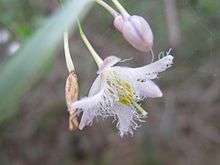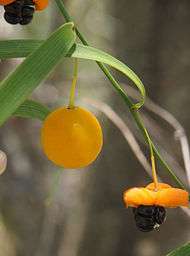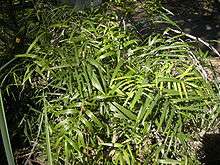Eustrephus
Eustrephus is a monotypic genus in the family Asparagaceae, subfamily Lomandroideae.[1][3]
| Eustrephus | |
|---|---|
 | |
| Flowers | |
| Scientific classification | |
| Kingdom: | Plantae |
| Clade: | Tracheophytes |
| Clade: | Angiosperms |
| Clade: | Monocots |
| Order: | Asparagales |
| Family: | Asparagaceae |
| Subfamily: | Lomandroideae |
| Genus: | Eustrephus R.Br. |
| Species: | E. latifolius |
| Binomial name | |
| Eustrephus latifolius | |
Eustrephus latifolius, commonly named wombat berry, is the sole species of evergreen vines which grow naturally in Malesia, the Pacific Islands and eastern Australia. They grow in sclerophyll forest, woodland, heathlands, shrublands, gallery forest and on the margins of and in rainforests.[4][5]
They have leaves with lamina variable in shape, elliptic to linear, 3–10 cm (1.2–3.9 in) long and 3–35 mm (0.12–1.38 in) wide. All leaf veins are equally distinct. Flowers are pink to mauve or white. The yellow-orange, globose, capsules of 1–2 cm (0.4–0.8 in) diameter contain numerous black seeds set in a white aril.[5] The variation in the shapes of the leaves has resulted in the creation of numerous infraspecific taxa over the years, none of which are recognised by most present-day systematists.[2]


Uses
The tubers are eaten baked, and have an earthy sweet flavour.[6]
The 1889 book 'The Useful Native Plants of Australia’ records that Eustrephus latifolius is a "climber produces sweet though only small tubers, which, however, are probably capable of enlargement through culture (Mueller)."[7]
References
- "Eustrephus%". Australian Plant Name Index (APNI), Integrated Botanical Information System (IBIS) database (listing by % wildcard matching of all taxa relevant to Australia). Centre for Plant Biodiversity Research, Australian Government. Retrieved 11 December 2013.
- Laferrière, Joseph E. (1995). "Nomenclature and type specimens in Eustrephus R.Br. and Geitonoplesium Hook. (Geitonoplesiaceae)". Austrobaileya. 4 (3): 391–399. JSTOR 41738875.
- Chase, M. W.; Reveal, J. L. & Fay, M. F. (2009). "A subfamilial classification for the expanded asparagalean families Amaryllidaceae, Asparagaceae and Xanthorrhoeaceae". Botanical Journal of the Linnean Society. 161 (2): 132–136. doi:10.1111/j.1095-8339.2009.00999.x.
- Hyland, B. P. M.; Whiffin, T.; Zich, F. A.; et al. (December 2010). "Factsheet – Eustrephus latifolius". Australian Tropical Rainforest Plants (6.1, online version RFK 6.1 ed.). Cairns, Australia: Commonwealth Scientific and Industrial Research Organisation (CSIRO), through its Division of Plant Industry; the Centre for Australian National Biodiversity Research; the Australian Tropical Herbarium, James Cook University. Retrieved 11 December 2013.\
- Harden, Gwen J. (2001). "Eustrephus latifolius R.Br. ex Ker Gawl. – New South Wales Flora Online". PlantNET – The Plant Information Network System. 2.0. Sydney, Australia: The Royal Botanic Gardens and Domain Trust. Retrieved 11 December 2013.
- Low, Tim (1991). Wild food plants of Australia (revised ed.). North Ryde, N.S.W.: Angus & Robertson. ISBN 9780207169304.
- J. H. Maiden (1889). The useful native plants of Australia : Including Tasmania. Turner and Henderson, Sydney.